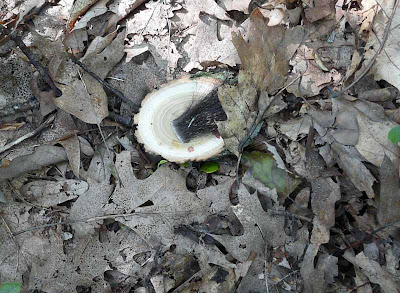A week ago the Daily Gazette based in Schenectady, NY, ran the below
article by Jim McGuire in their Sunday edition. The picture taken by the Gazette's photographer Ana Zangroniz reminded us how badly our barn needs to be painted!
Some explanation is needed as there seems to be some confusion about field trials in the article. Field trials have nothing to do with blood tracking training or blood tracking tests (the AKC has a good explanation of dachshund field trials on their
website). Anyway, we'd like to thank the Daily Gazette for promoting the use of blood tracking dogs!

Photographer: Ana ZangronizJolanta Jeanneney and her husband John play with two of their wire-haired dachshunds, Billy and Elli at their Berne home August 26. The Jeanneneys specialize in training dogs for tracking wounded deer and bears.
BERNE — John Jeanneney refers to the state’s band of leashed-dog trackers as “the agency of last resort.”
It’s a hunter thing. Others might not understand or may even recoil when Jeanneney explains: “We work when there is little or no blood.”
But what Jeanneney and the more than 150 state-licensed trackers do is actually humane. When hunters wound deer or bear and cannot find them, they can turn to the volunteer trackers who stand ready to drive considerable distances to begin a search.
The trackers and their trained dogs are usually successful. Since Jeanneney began pioneering the service in the mid-1970s as a permitted trial program watched over by the state Department of Environmental Conservation, he and his German wirehaired dachshunds have found 232 deer and three bear. Once on Long Island, he tracked a deer for nine miles.
He still has vivid memories of the time he and his dog came upon an aggressive buck that attacked them and injured the dog. It’s rare, he said, but sometimes “a deer will charge a dog.”
Since New York adopted legislation in 1986 and subsequent regulations in 1989 authorizing and licensing leashed-dog trackers, the program has been adopted by 16 other states. This month DEC gave its latest licensing exam to prospective recruits.
Jeanneney, the author of “Tracking Dogs for Finding Wounded Deer,” and the late Donald Hickman are regarded as the co-founders of the trackers’ association, Deer Search Inc., which started in 1978 and today offers 24-hour dispatch service.
Jeanneney, at 73, rates himself as “still going strong.” Each season, he estimates, he travels an average of 1,200 miles responding to calls for a tracker.
A tracker holding a state guide’s license may charge for this service, but Jeanneney said the majority of trackers are volunteers. He said hunters may make a donation to Deer Search, but it is not required. Deer Search reimburses trackers for their mileage.
DEC spokeswoman Lori O’Connell said the state leashed-dog tracking exam tests the tracker and not the dog. There are no field trials, she said, but part of the exam focuses on dog training.
There are rules and regulations governing the service, but no strict standards for tracking, O’Connell said.
One requirement that must be followed, she said, is notifying the local conservation officer before tracking begins.
NIGHT WORK
Jeanneney said trackers in New York, but not all the states, may carry a gun for protection and may work at night. Most trackers are not even notified until evening after hunters have given up finding their prey.
It is important to start immediately, Jeanneny said, because “chances are very good the coyotes will have it by morning … when they pick up the line of a wounded deer they know what to do with it.”
Darkness does not deter Jeanneney. “I’d rather work at night; the scenting conditions are better,” he said.
Jeanneney may prefer dachshunds, but he said he is open-minded about a tracker’s choice of dog. Others use beagles, bloodhounds, labs, basset hounds, golden retrievers, smooth dachshunds, drahthaars, dachbrackes and a number of additional breeds.
A good nose is necessary, but the training is key.
Jeanneney said he starts his dogs while only months old following the scent of a deer-liver drag. That technique gives way to more advanced training using tracking shoes that leave the scent of the deer’s interdigital gland, located at the top of the hooves.
It is that scent that all tracking dogs must follow on the job. Trainers use blood, but only sparingly, Jeanneney said.
Trainers make the field trials challenging by putting down cross tracks.
“A good tracking dog has to tune out the hot lines of healthy deer,” Jeanneney said.
Hunters and others seeking the services of Deer Search may contact DEC, a conservation officer or go to the Deer Search Web site.
 Hunter is a very accomplished blood tracker, and he has been foundation of Kevin's breeding. He is a son of our FC Sabina von Moosbach-Zuzelek.
Hunter is a very accomplished blood tracker, and he has been foundation of Kevin's breeding. He is a son of our FC Sabina von Moosbach-Zuzelek.
































